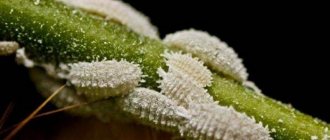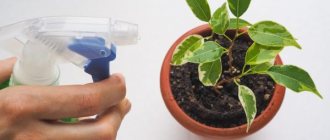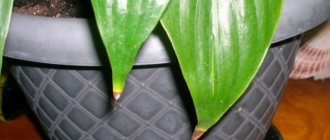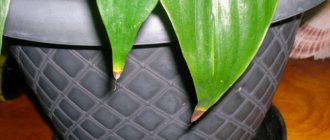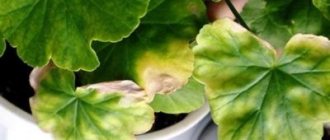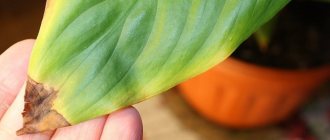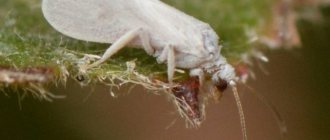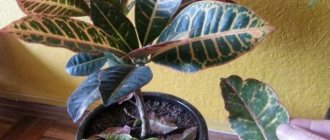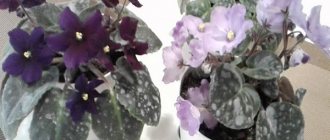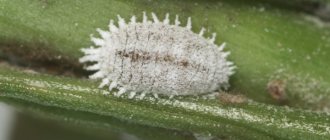Reasons for the appearance of a sticky coating on house flowers
If a sticky coating appears on the leaves of indoor plants, then you need to urgently look for the cause and eliminate it. In 90-94% of cases, stickiness on indoor flowers appears from various pests living on flower crops. The product of their vital activity covers the foliage in such a thick layer that an unpleasant substance begins to drip from the flowers.
A layer of sticky plaque, as well as white or brown spots on the green flowers, will “tell” about the presence of pests.
Where does the sticky layer come from:
- Sticky secretions and pinpoint marks are left by aphids and mealybugs;
- Scale insects leave growths and warts on the trunks of indoor plants;
- The stickiness on the underside of the leaf blades is caused by whitefly larvae;
- A sticky, thick white coating is created by spider mites.
How to identify a pest
A number of pests are known that leave a sticky layer on leaf blades. Indoor specimens are usually inhabited by arachnids or hemipteran insects. They are well adapted to life indoors, are small in size, and cannot be seen without the use of a magnifying glass.
Paths of entry of pests:
- With soil for replanting. Pre-disinfect new soil or bake it in the oven to destroy eggs and larvae.
- With purchased plants. Beginners should be kept away from existing flowers.
- With air from the street during ventilation. To avoid this, install mosquito nets on your windows.
Whatever the reasons for the appearance, no matter who is responsible for the appearance of sticky leaves on indoor flowers, it is necessary to get rid of the disease immediately.
Aphids are small insects, body length is 2-3 mm. It is painted white or greenish and prefers indoor flowers with delicate fabrics. Often one of the first signs of infection is the appearance of syrup-like droplets of secretory fluid.
When the colony grows significantly, the entire lower surface of the leaf blades is covered with parasites that destroy young shoots, prevent buds from opening, and can introduce fungus.
Shchitovka
The hemiptera family, to which the scale insect belongs, has more than 2,600 species, most of which are dangerous pests that destroy garden and indoor plants. The scale insect is small in size, the length of the oval body is 2 mm. Having settled on a houseplant, an insect can lead to its death in a short time. Yellow spots appear at the attachment site, the leaves curl and fall off. The flower stops growing and dries up.
An important sign of the appearance of scale insects on indoor flowers is a sticky coating. A viscous white liquid is honeydew, capable of completely covering the flower. Honeydew easily collects sooty fungus and dust.
The closest relative of this pest is the false scale insect; they belong to the same order and lead the same parasitic lifestyle. False scale insects are larger. It is not so easy to understand whether it is a scale insect or a false scale insect in front of you. It seems that the false scale insect has a shell on its back, but this is a layer of skin that has died off after molting.
The main pest of indoor flowers is the soft scale insect; it can destroy any plant. The insect size is 3-4 mm, the oval body has a brown color. The insect leaves a sticky coating not only on the leaves, but also on the window panes near which the pot is located.
Spider mite
This small pest from the class of arachnids is almost impossible to see with the naked eye; its size is 0.2-1 mm. They feed on plant cell sap; their salivary glands secrete special enzymes that destroy cell chloroplasts . The red spider mite can destroy any indoor plant; it loves warmth and does not tolerate excess moisture . Shiny reddish eggs can be seen on leaves or webs. After the allotted time, translucent larvae emerge from the eggs, which also feed on the juices of the flower.
Scale insect - a dangerous insect
If the thyroid gland is active, then expect trouble. This pest is difficult to detect immediately.
How to destroy scale insects on indoor flowers
Useful advice from an agronomist
I am not a blogger from the twelfth floor, but a practitioner who has connected my entire life with my mother-nurse - the EARTH. I have something to tell you about the earth and everything growing on it
Ask a Question
Among the many pests of indoor flowers, a special place should be given to the scale insect, this inconspicuous plant killer that sucks the juice from the plant. She does not fly, does not crawl, and therefore we sometimes notice her very late. Only when we are already trying to understand why our pets are oppressed, do not grow, and sometimes simply die. How to often inspect the flowers in the house, find this pest, and how to deal with them - in this film. Look at it carefully
What do scale insects look like?
The adult insect is covered with a hard brown shield, under which hordes of eggs are hidden. The female pests bite tightly into the leaf and use their proboscis to draw juices out of the plant.
If the females sit motionless, then the males move from place to place, infecting the seedlings of the home greenhouse bush by bush. They themselves do not eat foliage, but they can move around and infect.
The scale leaves a sweet sticky trail or honeydew without a break to rest. Females are so fertile that they bear offspring 5-6 times throughout the year.
The tenacious insect does not rest even in winter. Colonies of the pest grow so quickly and abundantly that they can take over the entire home greenhouse. Even poisonous flowers are not spared.
How do they get into the house? They can fly through windows with the wind and get into a house with a plant that was purchased at a flower shop.
These pests are omnivores. They are ready to eat: palm trees, citrus fruits, bromeliads. Females happily live on orchids, lemons, ficuses, ivy, crassula, and cacti.
What does a scale insect look like?
The eggs of the scale insect are oval in shape; in some species they are elongated oval, usually white or light gray in color, gradually darkening to light brown. The eggs are very small, approximately 0.1-0.3 mm, and look like worms under a microscope.
The first instar larva is called a vagrant
- it has a flattened oval body, up to 0.3 mm long, yellowish in color, three pairs of legs, antennae, eyes. In many species of scale insects, you can tell by the color of the larva what it will regenerate into. So, in the mulberry scale, the strays are white and red, the white ones grow into females, and the red ones into males. The second instar larva is larger. Its body is white or gray, the back of the body is usually darker, its dimensions reach 0.5 mm. At this point, the female larva has no legs, antennae, or eyes. It is distinguished from an adult individual only by its size and lighter coloration of the shield. Among several thousand species, there are scale insects of a slightly different appearance - some have females with an almost transparent body, the shield is invisible, they seem to be glassy; others have very irregularly shaped bodies, like blobs; still others have a rich black shield. The morphological stages of development of scale insects may also differ; for example, some tropical scale insects do not have an egg stage. There is no point in describing a specific type of scale insects; once you see them in photographs or in person, you will no longer confuse them with anyone else.
Mealybug
A white sticky coating, similar to a cobweb, is a sign of the formation of a clutch of mealybug eggs. The parasite lays a large number of eggs under the web.
What does an insect look like?
An adult female, no more than 5 mm long, comes in pink, white, and beige colors. Along its body there are small bristles covered with a white powdery coating.
To immediately notice that something is wrong, pay attention to whether sticky drops appear on the plant. This is the first stage of infection of a green pet.
Next, a sticky white coating forms, resembling pieces of cotton wool. At the last stage of infection, a change in the shape of flowers and leaves occurs. The leaves take on a marbled color and are covered with spots of red or yellow.
When leaf blades change, photosynthesis is disrupted and the plant dies.
The reasons for the appearance of this pest: dry air, temperatures above plus 20ºС, unfavorable conditions for development. Most often, the pest multiplies in winter, when there is a lack of lighting, dry air, and excessive watering, leading to stagnation of water in the soil and pan.
The most dangerous phenomenon in winter is waterlogging. Too much water in the soil leads to rotting of the roots, the appearance of parasites and microbes. When watering, you should pay attention not to the interval between waterings, but to the condition of the roots.
Causes and symptoms
White coating on houseplants can be caused by a fungal disease or a pest that can create a white coating on the plant. If you care for your plants properly, pests or diseases will be kept to a minimum. But a situation may arise where diseases and pests can harm your plant.
- - a decrease in temperature below optimal conditions, usually below 10 degrees.
- — excess moisture in the pots or high humidity can cause diseases.
- - excess nutrients. Increasing the permissible norm of nutrients (fertilizers) can contribute to the development of diseases.
- - the reason for the deterioration in appearance may be the fact that the plant becomes cramped in its own pot. In other words, he has outgrown it.
- — violation of the watering regime (severe drying or excessive watering).
- - fungal diseases can be airborne (spores) or may be contained in irrigation water.
Any violation of the conditions for growing indoor plants reduces immunity and opens up the possibility of damage by pests or diseases.
What to do if the leaves become sticky
What measures to take if a sticky coating appears on an indoor flower? First of all, you need to inspect the seedling. Sweetish drops may also appear on healthy plants during flowering. This natural function is needed to attract pollinating insects. After flowering ends, the drops will disappear.
Gum disease can affect citrus and other flower crops, even without pests appearing on them.
If an amber sticky liquid appears on the foliage and bark of citrus fruits, the cause may be excess nitrogen, damage to the trunk, fungi, or improper planting.
Sticky droplets can appear on branches, buds and leaves of other indoor plants. You just need to change the fertilizing and maintenance conditions, and treat the fungus with fungicides.
But if scale insects or other pests have taken a fancy to your plant, then you need to urgently take action.
Controlling sticky pests
Any diseased plant should be sent away from the greenhouse, and other crops should be examined. Infected seedlings should also be quarantined.
Treatment of an infected bush:
- Wash the flower with hot soapy water, dissolving a piece of laundry soap in it.
- After washing off the honeydew and some of the insects, rinse the window and windowsill, and wash the curtains. Parasite larvae may also remain here.
- Buy “green” soap at a flower shop, beat it into a thick foam, and carefully wipe the leaves with a sponge soaked in a soap solution.
- There is no need to wash off the soap right away. After 15 minutes, rinse the plant under a hot shower, then dry in a warm place.
What to do with brown scales
What to do with adult female scale insects? They look like brown scales or bumps, settling on the trunk in the most inaccessible place.
How to remove pests:
- First you need to cut off all diseased leaves and branches of the seedling;
- Use a cotton swab dipped in alcohol to remove any insects that can be reached;
- Pour 10 ml of alcohol into the solution (beat 20 g of laundry soap in 1 liter of water);
- Use a cotton pad to distribute the prepared solution over the scales;
- Next, rinse the leaves with the solution, top and bottom, especially along the veins;
- This treatment of the plant must be carried out 3 times every 10 days. After this treatment, the scale insect should disappear.
Important! Insects should not be removed by hand. Damage the scales and the population will multiply at lightning speed.
Treatment of different types of white plaque
In most cases, a white coating on the leaves and soil is a signal that the plant is not maintained correctly. Therefore, it is necessary to change these conditions to the correct ones, and, if necessary, begin immediate treatment of the flower.
How to get rid of mold?
An algorithm for certain actions is required here:
- if mold appears only on the top layer of soil, then you can simply remove it by collecting it with a spoon;
- if there is a need for replanting, the roots of the extracted plant should be washed, dried and only then replanted into new soil;
- after these operations, it is recommended to sprinkle the soil with soda or cinnamon;
- If mold appears on the leaves, they should be wiped with damp paper napkins.
It is better to perform the procedure outside in bright sunlight, if the air temperature allows. After treatment, the flower must be sprayed with fungicides.
It is better to cut off such affected leaves and discard them. It is very difficult to remove active mold that has penetrated the inside of the leaf.
What to do if it looks like cotton wool?
Cotton wool is a sign of the presence of mealybugs. To get rid of this parasite, you don’t have to run to the store for chemicals. There are quite effective folk methods.
- Brew calendula powder (sold in a pharmacy) like tea, cool and treat the plant with it (per 100 g of powder - 1 liter of water);
- chop the garlic, pour boiling water over it and let it brew for 3-4 hours, apply to the leaves using a sponge;
- Dilute 1 tablespoon of olive oil in 0.5 liters of water and spray with a spray bottle.
If the above procedures do not help, it means that the lesion has eaten deep. Then you will have to use chemicals.
The following drugs help well against scale insects:
- Decis;
- Bi-58;
- Fitoverm;
- Tsvetofos.
Chemicals
After treating with a soap solution, you can finish the fight with the help of chemicals. They act more effectively in May-July, when the females are still without protective shields. The best preparations for spraying: Fitoverm, Aktara (KS, VOP).
Processing stages
- After spraying with insecticide, the flower should be covered with a bag and left for 40 minutes.
- Then rinse the seedling in the shower to remove the chemical and dead individuals.
- After 2 weeks, repeat spraying to destroy hidden beetles.
- Check all indoor flowers regularly using a magnifying glass.
Efficiency of Aktara
"Aktara" is a new generation insecticide. It has characteristics such as high efficiency and versatility in use.
This drug is toxic, so all precautions must be taken when using it. It is especially dangerous to inhale the vapors of this product. While working, you must wear gloves, a protective mask and goggles.
If home vegetation is attacked by parasites, then “Aktara” will help cope with them.
"Aktara" is a fast-acting insecticide with enteric contact action. The product is available in granules and suspensions. Its substances have a detrimental effect on many insects.
Advantages of "Aktara":
- It has a high degree of absorption, so the drug is capable of destroying more than 100 types of pests;
- The impact on pests is rapid. After an hour, you can notice the death of the parasites;
- Plants can be treated at any time and in any weather;
- The drug can act for 1 to 2 months;
- Without accumulation effect, therefore does not harm crops.
Disadvantages of Aktara:
- Harmful to bees, wasps, hornets;
- It is not recommended to store in a diluted state.
Dilute the drug only according to the instructions. Treat only trunks, leaves and roots, avoiding flowers and ovaries. After treatment, the flowers should stand for 24 hours, preferably under a bag. Dilute the product only with warm water.
If pests have dug into the root zone, then watering with Aktara will help protect the entire plant. The root system will begin to promote the drug substances throughout all cells of the culture, and the parasites will quickly become saturated with poison.
“Aktara” will destroy their digestive tract, as a result the nerve endings of the parasite will be paralyzed, so the insect will no longer want to suck the juices from the plant. Without food it will soon die.
Prevention is easier than cure
Fixing a problem is always more difficult than preventing it. Following simple rules saves time and allows you to grow indoor flowers healthy and beautiful.
- Do not water flowers with tap water. It needs to be defended, and for prevention it is sometimes recommended to soften it with citric acid.
- Do not overfill and watch the drainage holes so that they do not become clogged.
- Keep the container with the plant away from heating devices, spray and humidify the air in the room more often.
- The volume of the pot should be selected according to the size of the flower.
- To prevent fungal diseases, activated carbon is used once a month. A good disinfectant is a weak solution of potassium permanganate, which can be used for irrigation instead of ordinary water.
- In winter, fertilizing with fertilizers should be stopped, and loosening the soil will only be beneficial.
Why sticky plaque is dangerous for indoor plants
If the leaves become sticky, take immediate action. First of all, armed with a magnifying glass, inspect the plant. Perhaps there are dangerous parasites among the foliage.
Let's look at leaf diseases and treatment of different flowers.
Sticky leaves on an orchid
Owners of orchids strictly monitor the health of their pets, but these luxurious flowers are also attacked by pests. Sticky leaves on an orchid may indicate a mealybug infestation.
To prevent the orchid from being affected by scale insects, it is necessary to perform the following actions:
- Inspect flowers frequently;
- Create favorable conditions, that is, illuminate and humidify the air in winter by placing a bowl of water next to the flower;
- Wipe the orchid leaves with a solution of laundry soap;
- For transplantation, buy an uncontaminated substrate or disinfect it after purchasing it at home;
- Dry the homemade bark for 15 minutes in the oven at 60 ℃.
- Cut off affected leaves and flowers.
Often sticky drops of nectar appear on the leaves of the orchid. This is a natural process, the flower seems to “sweat”. Drops are simply washed off with water.
Other reasons for the appearance of stickiness on leaf blades: excessive watering, excessive fertilizing, infection with scale insects or aphids.
Phalaenopsis orchid
Flowers of the Phanelopsis variety are distinguished by a variety of colors, and therefore are in a special place among gardeners. In the process of growing phalaenopsis, many problems also arise that cause anxiety to the owner. One such problem is sticky spots on leaves.
Stickiness is a distress signal, or it may be a natural process. As a flower grows, moisture moves through the plant, forming nectar. Thus, the leaves of the phalaenopsis are covered with a sweet substance or nectar.
Droplets on leaves attract pollinators or ants. In nature, ants are excellent at destroying aphids, so the sticky coating is useful for this crop.
Sweet nectar also serves as a trap for harmful microorganisms. Getting entangled in the sweet substance, they simply die.
Reasons for the appearance of nectar:
- Excessive watering;
- The accumulation of moisture in the pan or in the substrate causes the plant to emit evaporation;
- Low temperature;
- Excess fertilizing with phosphorus, potassium and nitrogen.
Oversaturation with fertilizers and moisture leads to the release of excess sugars. Even this seemingly natural process can have a detrimental effect on the health of the flower. Dark spots appear on the leaves, which interfere with photosynthesis. To save a blooming pet, it is necessary to completely replace the substrate, otherwise the death of the flower rosette and the flower stalks themselves will occur.
The nectar that appears on the leaves of the flowers can be wiped off with a wet sponge and put the flower in the shower. It doesn’t hurt to take a good look at each leaf under a magnifying glass so as not to miss pests.
Ficus
If this large indoor flower gets sick, sticky leaves will be the first symptom of the disease. Stickiness just confirms the presence of pests attacking the flower crop.
Let's consider the reasons for the appearance of a sticky substance on the ficus. Ficus can be affected by spider mites. If the leaf blades are covered with white dots, and the rest of the ficus is covered with a thin cobweb, then start fighting spider mites. Spider mites develop quickly in dry air and high temperatures.
But thrips can also cause sticky leaf blades. These pests are very similar in appearance to small flies. They feed on plant sap and live in large colonies. By sucking the sap of a plant, they can destroy it.
Scale insects and aphids can also attack ficus plants. If your ficus has sticky leaves, don't rely on luck. Without eliminating pests, the problem will not be solved.
Drugs such as Actellik, Vermitec and Flumite will help get rid of spider mites. To completely destroy the insect, 3 treatments will be needed at intervals of 5-7 days. Thrips are killed by the same insecticides as spider mites.
The ficus benjamina also produces sticky leaves. If there are few insects, then it is enough to wipe the ficus leaves with a sponge dipped in a soap solution.
Large colonies and scale insect larvae die after treatment with an insecticide, for example, Actra. It will be necessary to treat the diseased seedling three times, allowing an interval of 7 days between treatments. In order for the pests to die, after treatment the plant must be covered with a bag and kept under cover for a day.
Important! After destroying the parasites, the Ficus Benjamin needs to create better conditions: increase lighting, raise the temperature and humidity, establish the correct watering regime so that the pests do not return.
Begonia
Begonia is a favorite flower of many gardeners. Begonias and sticky leaves don't seem to go together. But it can also be attacked by the same pests.
Begonia can be destroyed by pests such as thrips, scale insects, and spider mites. The appearance of pests can be noticed by changes in the stem of the plant. It begins to shrink and age quickly. At the same time, the state of the begonia does not confirm the presence of parasites: the leaf is shiny, the color is lush.
Thrips are the most dangerous for begonias. To get rid of this parasite, many gardeners cut off clean, uninfected shoots from the plant, wash it with water, root it and plant it in a clean pot. The mother bush can also be saved by treating it with Fitoverm.
Anthurium
A blooming anthurium brings many pleasant moments to its owner. It blooms with incredibly attractive flowers of pink, white, bright red, and purple.
Often this flower is attacked by various parasites, affecting the beautiful leaves. White sticky coating, dark or light spots, cobwebs under the leaves - all this indicates that the flower is damaged by pests.
If you wash the tops of the foliage and under the leaves with a soapy solution, most of the insects will be removed. If the disease is advanced, more stringent measures will have to be taken.
The plant can be saved from aphids using a folk remedy: leave 15 grams of chopped onion or 6 grams of dry scales in 1 liter of water for 5 hours. Spraying is carried out three times, with an interval of 5 days.
In advanced cases, you will have to treat with Fitoverm, Actellik, Karbofos, Biotlin. Treatment with Fitoverm will save you from thrips and spider mites.
Chinese rose
The lushly blooming Chinese rose is a real decoration of a home greenhouse. Flower growers treasure this beautiful flower. One of the unpleasant aspects of breeding is the appearance of sticky leaves on Chinese roses.
There is no need to despair; it is worth understanding the reasons for the stickiness of the leaves. A careful inspection of the flower crop will help eliminate or detect pests. A sticky coating is created by aphids, scale insects, and whiteflies.
If parasites are found, then they must be combated with the help of chemicals. You will have to treat both the plant itself and the soil.
If no parasites are found, but there are still sticky drops, it’s worth looking into this phenomenon. Often, especially in hot weather, small sticky droplets appear on the back of Chinese rose leaves. They usually appear after watering during hot periods. The plant seems to “sweat”. This is a normal natural phenomenon.
The unpleasant thing is that drops of nectar drip and stain everything around. How to get rid of this phenomenon? You can get rid of it if you give the plant “bathing” under a hot shower more often. It has been noticed that the rose loves water treatments!
It's worse when pests are discovered. If brown tubercles are found on the trunks, then these are sucking insects - scale insects and false scale insects draw sap from the plant.
The leaf under the scale is lighter than the rest of the leaf blade. This sign can also help identify the parasite.
Mealybug - also leaves stickiness and spoils the plant. It looks like a fluffy, round insect, and when crushed it releases an orange liquid.
Thanks to the waxy coating, the bug is protected from the effects of contact drugs. It must be combated with intestinal drugs.
Treatment with Aktara will help get rid of these pests. Dissolve 4 g of the product in 5 liters of water, spray the flower, and then spill the soil with this solution: 1 g per 10 liters. Carry out the treatment 4 times with an interval of 7-10 days.
If the plant is not neglected, it will require treatment (after 1-2 days) with acarin, agravertine, and fitoverm.
Citrus
Growing citrus fruits is not just fashion and delicious fruits, but also purifies the air in the apartment.
Much to the regret of many flower growers, indoor lemons are plagued by harmful insects, whose activity causes a sticky coating to appear on the trunk and leaves.
Sometimes indoor lemons have sweet droplets on the leaves, as if syrup had been sprinkled on it. One of the reasons is considered to be excessive watering. Lemon should not be watered so much that the soil is always moist.
If watering is adjusted, and stickiness appears on the lemon leaves again, then look for scale insects. This insect can blend so well with the bark of a lemon tree that you won’t immediately notice it.
Signs of scale insect infestation:
- dry spots of brown color;
- sticky coating on the trunk and foliage of a tree.
Scale insects most often attack weakened young trees. It is necessary to feed citrus seedlings with complex fertilizers 4 times a year.
If you do not get rid of this insect, it will quickly increase its habitat area. But spraying with chemicals can cause the fruits of the current and next harvest to become poisonous and cannot be eaten.
Therefore, insects must be detected as early as possible and sprayed with less aggressive means:
- Dilute 10 ml of 70% alcohol and 15 ml of laundry soap in 1 liter of water;
- Protect the soil from contact with the solution;
- Apply the product directly to the affected areas.
If the scale insects have not disappeared, then every 3 days you will have to spray with “Confidor” or “Aktar” until the pest completely disappears. When spraying, pay attention to the root zone and the underside of the leaf blades.
The harvest of this year, as well as the next season, cannot be eaten.
Warmth and high humidity can attract whiteflies. It is signaled by a white coating on the foliage, similar to mold. Wipe the leaves with a sponge dipped in soapy water.
Spraying with a sweet solution works well. For 1 glass of water you will need 2 tbsp. spoons of sugar. A week after the sweet spray, put the lemon in the shower.
Try to get rid of mealybugs by rubbing the stems and leaves with garlic infusion: crush 6-7 cloves of garlic and pour 0.5 liters of hot water, leave for 4 hours.
Mandarins can also be attacked by sucking insects. The treatment is the same as for lemon. And it is best to carry out preventive measures: often examine the trees under a magnifying glass, arrange a hot shower, and create favorable conditions for growth.
Calathea
The calathea flower attracts attention with its beautiful large leaves. But sometimes sticky streams appear under the leaves. This is a warning sign. Perhaps the flower was attacked by dangerous pests: scale insects or spider mites.
Due to the fact that the flower has large leaves, you can limit yourself to wiping them with a sponge dipped in a solution of laundry soap.
The most dangerous pest for calathea is the spider mite. It can be detected by a dense white web and the appearance of white spots on the leaves.
It attacks calathea if the air in the room is too dry. Therefore, it is necessary to achieve normal air humidity. Place a container of water near the flower, arrange a shower, and wipe the leaves on both sides more often.
Caring for a sick plant
In the process of fighting parasites, the substrate in which the orchid lives must be washed once every ten days.
This is done like this:
- place the pot in the bucket;
- dilute Alirin-B in slightly warm water (2 tablets);
- pour liquid to the ground level;
- After 5 minutes, remove the flower.
In case of infectious lesions, the plant is provided with the most comfortable conditions for it.
Make sure that the temperature always remains within +22 °C...+25 °C in summer and +16 °C...+18 °C in winter. Try to keep the air at night not cooler than during the day by more than 5 degrees.
Provide your pet with light. During illness, extend the day to 14 hours using a phytolamp. Be sure to protect the orchid from the sun.
During the treatment of various rots and fungi, it will be necessary to maintain low humidity. Here the optimal figure is a maximum of 50%.
Ventilate the room more often - microorganisms do not like fresh air.
It is better to refuse feeding during the period under review. The only exceptions are iron-containing drugs.
Give water little and rarely. Be sure to wait until the soil is completely dry.
Continue treatment for at least 2 weeks, even if symptoms (and the same sticky patches) have disappeared. Infections can recur. Upon completion of the course, it is advisable to transplant the flower into a new substrate (in emergency cases, this is done at the very beginning).
Remember that pests always lay eggs, which are not affected by insecticides. You need to wait until the larvae hatch and carry out a new treatment with pesticides. This usually takes from 10 to 15 days.
When should you worry?
- Of course, there is no reason to panic if the process of the appearance of sugar drops is physiological. It happens that domestic plants, just like their wild relatives, try to attract insects for pollination. Sweet nectar in this case serves as a kind of bait. At the same time, the orchid grows well, develops fruitfully, and there is no other reason for concern. Sweet baits into which insects fall can subsequently negatively affect the health of exotic fish. There may be a risk of contracting infectious diseases.
If the reason lies in excess nutrients, this is already serious. Through sweet drops, phalaenopsis removes excess nutrients. Which is dangerous, because an excess of fertilizing leads to the formation of rot, death of the peduncle and rosette.- If there are harmful insects and powdery mildew, it is worth worrying about. Immediately after confirming probable assumptions, begin active actions. The more advanced the condition of the orchid, the more difficult it will be to cure it.
How to deal with plaque
But this procedure is not always possible to perform immediately. In this case, you can do the following:
- Remove about two centimeters of the top layer of soil so that the mold and root system do not come into contact.
- Bring the watering regime back to normal and avoid over-moistening the soil.
- If the soil is heavy and dense, it should be loosened carefully. This will help remove excess water and normalize gas exchange.
If using these methods it is not possible to remove the white plaque, then you can use folk or store-bought remedies to combat mold.
Folk remedies
If the focus of infection is small, and the white coating appeared not so long ago, then you do not need to use strong chemicals.
a solution of citric acid is often used to cultivate land . Take 2-3 grams per glass of water. This product can be watered no more than twice a month. It can be used for plants that can grow in acidic soil.
You can also use regular garlic . To do this, make an infusion or bury several cloves around the flower. During watering, phytoncides will enter the soil, which prevent the spread of pathogens.
Wood ash can also disinfect the soil. It also quickly removes excess moisture from the soil. Depending on its capacity, take from 30 to 100 grams of ash per pot. It is sprinkled around the flower and mixed with the top layer of soil. It is important not to touch the roots of the plant.
Purchased funds
To combat white plaque, the following drugs are used:
- Sarfun 500 sc . Produced in the form of a concentrated suspension. This is a broad-spectrum fungicide that has a therapeutic effect. The plant and soil surface are sprayed with it.
It is best to do this during the growing season. The drug is also used to prevent the appearance of mold on the ground.
Protects the flower for a month and is not washed off when spraying the leaves. Destroys the fungus in about a day.
It is recommended to perform the procedure in the morning or evening. When processing the plant, it is important to ensure that the drug does not get into your eyes. Topsin M. This is a systemic contact fungicide that is used to treat and prevent fungal infections. In addition, it copes well with parasites.
The main active ingredient is topsin. Produced in the form of an emulsion or powder. Has a beneficial effect on shoots. After treatment, the flower begins to develop better. The action begins on the first day after treatment. The procedure is repeated after 2 weeks.
Azophos . One of the most effective drugs. Quickly suppresses the development of fungus, and also provides nutrition to the flower, nourishes it and promotes growth.
Its action is similar to Bordeaux mixture, since the drug destroys fungal spores.
Powdery mildew is a disease caused by ectoparasitic microscopic fungi; it can develop not only on the leaves, but also on the fruits of some plants, as well as on the above-ground parts of the shoots.
To identify the problem, you can conduct a small experiment - try rubbing the area that was affected by the disease. If it really is powdery mildew, small pellets appear on your fingers; they will consist of mycelium threads, and very small ones at that. Gardeners advise fighting this fungus with drugs - fungicides developed on a sulfur basis.
Cause of powdery mildew
The fungus lives in almost every indoor plant, but it does not always manifest itself and begin to destroy the plants. When the plant is provided with timely watering and proper care, mealy fungi have no chance. Fungi parasitize and reproduce in the following cases:
- If it's cool outside, about 12 - 15 degrees, rainy season, high humidity. Outdoor conditions do not affect indoor plants as much as they do on plants located on the balcony. Therefore, in bad weather, balcony plants should be moved to a warmer place.
- If the soil is oversaturated with nitrogen
- Lots of vegetation in the pot and little space
- Improper care, not timely watering. If the plant is often watered and the earthen lump does not have time to dry out, or vice versa, the earth constantly dries out, and then it is watered abundantly
Since this disease is portable, it is very easy to infect other plants:
- If you touched a diseased plant, then touch a healthy one
- If mealy fungi get into the irrigation water
- Even when airborne, spores can infect neighboring plants.
Avoid contact with fungus
